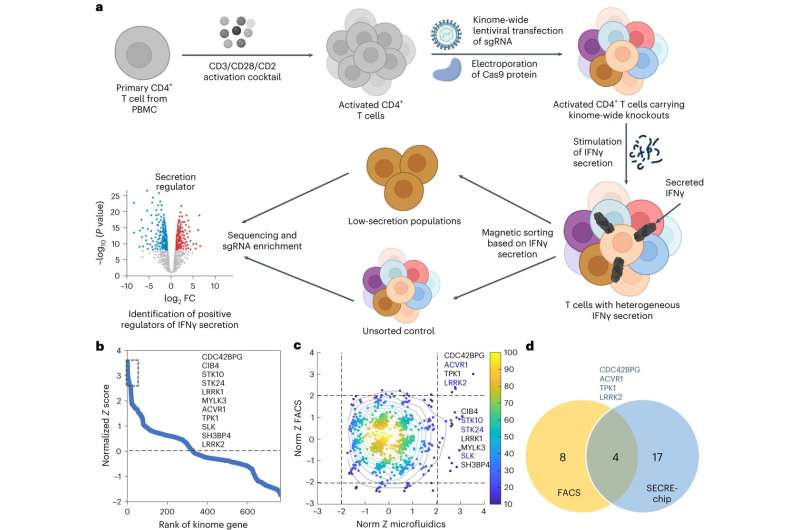This article has been reviewed according to Science X's editorial process and policies. Editors have highlighted the following attributes while ensuring the content's credibility:
fact-checked
peer-reviewed publication
trusted source
proofread
Scientists devise new technique that can pinpoint causes, treatments of autoimmune diseases

Scientists have developed a potentially transformative new technique that could aid in the discovery and development of new therapeutics for a number of globally prevalent autoimmune diseases.
Conditions such as lupus, rheumatoid arthritis and inflammatory bowel disease (IBD)—as well as failures within transplanted cells—are all caused by altered cytokine secretion of immune cells within the human body.
To find treatments for such diseases, experts need to identify the genetic regulators of the secretion so they can explore the most effective ways of inhibiting them.
An international team of researchers has developed a new method, referred to as Secretion-Enabled Cell Ranking and Enrichment (SECRE) and detailed in a study published in Nature Biomedical Engineering.
They have demonstrated the method is accurate in sorting hundreds of millions of CRISPR-edited cells based on their secretion patterns, and identifying the genetic regulators of cytokine secretion in an autoimmune condition. In addition to this, the method takes into account the detailed profiles of approved treatments, and those under development, to establish if therapies already in existence can be reapplied in new ways.
Writing in the study, the researchers detail how they have validated their approach on the cells known to play an essential role in the development and severity of IBD, and proved it has the potential of finding new ways of treating conditions that impact millions of people globally.
The research is the result of a project lasting about four years between scientists in the U.K., U.S. and Canada, world-leading experts in engineering new tools for the diagnosis and treatment of disease, led by Professor Shana Kelley, President of the Chan-Zuckerberg Institute and Professor at Northwestern University.
Dr. Mahmoud Labib, Lecturer in the University of Plymouth's Peninsula Medical School, and the main inventor of the approach said, "This is an incredibly novel approach that can potentially deliver huge benefits for patients, clinicians and the drug companies working to establish new treatments. It gives us the ability to sort large number of cells based on their secretion patterns and identify therapeutic targets that could be applied to help those with conditions for which there are currently few therapeutic options.
"Through our existing work, we have demonstrated there is the potential for it to help identify ways of treating various autoimmune conditions, but my work is also now extending to types of cancer including some of the most aggressive types of brain tumors."
A potential treatment for inflammatory bowel disease?
Inflammatory bowel disease (IBD) is a long-term health condition that has been estimated to affect about 7million people worldwide. It is characterized by chronic inflammation of the digestive tract, which can result in severe tummy pain and diarrhea, and there is presently no known cure.
As part of work to validate their approach, the researchers examined the effect of several kinase inhibitors on CD4+ T cells, which are known to produce interferon gamma, a protein widely implicated in several autoimmune diseases including IBD. The inhibitors looked at included XMU-MP1, a small molecule that has previously been explored as a treatment for heart failure, hair loss and a number of other medical conditions.
In this instance, the researchers used XMU-MP1 to treat mice with a form of colitis that has a similar cell secretion profile to that found in humans with IBD. They found the mice experience significantly less weight loss and reduced colitis symptoms, while their colons remained virtually normal in appearance and did not show any significant loss of intestinal stem cells.
Based on these findings, the researchers say their results suggest that using XMU-MP1 as a means to inhibit interferon gamma production in the gut may represent an ideal means to control IBD. They also say it provides a promising future strategy for the therapeutic molecular targeting of the condition, although extensive clinical trials would be required before it could be considered as a treatment.
How the SECRE technique works
The Secretion-Enabled Cell Ranking and Enrichment (SECRE) technique captures the secreted cytokine on the surface of the cell. These cytokines are then labeled with magnetic nanoparticles and sorted at high resolution within a microfluidic device, fabricated using scaled three-dimensional printing.
The SECRE technique enables rapid and high-throughput sorting of cells based on their secretion patterns, which makes it amenable to large-scale functional genetic screens. This approach also links the functional signature of the cell with its phenotype, allowing for selective sorting of specific subsets of immune cells on the basis of specific cell-surface markers as well as the secretion specific factors.
More information: Mahmoud Labib et al, Identification of druggable regulators of cell secretion via a kinome-wide screen and high-throughput immunomagnetic cell sorting, Nature Biomedical Engineering (2023). DOI: 10.1038/s41551-023-01135-w



















